The Jefferson nickel is among the most recognized coins in the US and the 1991 nickel is just one of its many series. First struck in 1938, the Jefferson nickel has stood the test of time and has become a popular coin among collectors.
So, if you want to learn more about the 1991 5-cent coin, then you need to continue reading.
What Is the 1991 Jefferson Nickel Made Of?
The 1991 Jefferson nickel is made of 75% copper and 25% nickel. This is the same composition that you’ll find in Jefferson nickels struck from 1938 to this day. Of course, the only exception so far would be the ones struck from mid-1942 to 1945. Nickels during these years are referred to as “Wartime Nickels” and they are made of 9% manganese, 35% silver, and 56% copper.
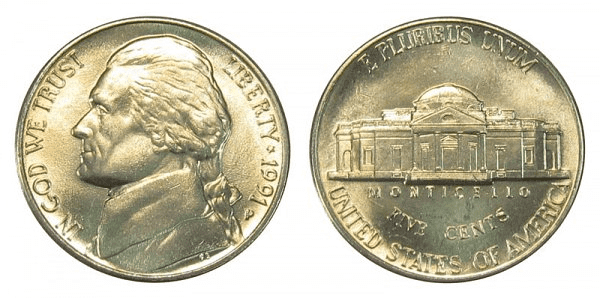
Here are some specifications of the 1991 nickel that you should know:
- Value – 5 cents
- Diameter – 21.21 mm
- Mass – 5 grams
- Years of minting – 1938 to present
The original version of the Jefferson nickel was designed by Felix Schlag after winning the open competition held by the US Mint. The same design was used in the 1991 nickel coins.
The obverse of the coin features the face of Thomas Jefferson, the third president of the United States and also one of the people who helped found the nation.
Aside from Jefferson’s image, there are inscriptions found on the obverse. These are the following:
- LIBERTY
- IN GOD WE TRUST
- 1991
- Mint mark
On the reverse, you’ll find Monticello, the mansion owned by the third president. Inscriptions include the following:
- E PLURIBUS UNUM
- MONTICELLO
- FIVE CENTS
- UNITED STATES OF AMERICA
The Jefferson nickel replaced the hard-to-mint Buffalo nickel. While the Buffalo nickel is a well-regarded coin today, they are difficult to produce and the die needs constant repair. Thus, in 1938, the nickel had a new design, which included Jefferson’s image.
Today, nickel is widely circulated and there are billions of them. Schlag’s design has already been replaced in 2006 by Jamie Franki’s design.
1991 Jefferson Nickel Varieties
The 1991 Jefferson nickel comes in three varieties. They actually look almost the same except for their mint mark, which shows you where the coin was struck.
Here is a summary of the 1991 Jefferson Nickel Varieties along with their mintage:
| Variety | Mint Location | Mintage |
| 1991 D Jefferson Nickel | Denver | 436,496,678 |
| 1991 S Proof Jefferson Nickel | San Francisco | 2,867,787 |
| 1991 P Jefferson Nickel | Philadelphia | 614,104,000 |
| Total | 1,053,468,465 |
At the end of 1991, the US Mint produced more than a billion Jefferson nickels. Here’s a deeper look at each of the 1991 nickel varieties.
1991 D Jefferson Nickel
Year of minting: 1991
Mint Mark: D
Minted in: Denver
Quantity produced: 436,496,678
Face Value: $0.05
Price: $0.10 and $0.20 (circulated condition)
Mass: 5.00 grams
Edge: Plain
Designer: Felix Schlag
Composition: 75% Copper, 25% Nickel
Diameter: 21.20 millimeters
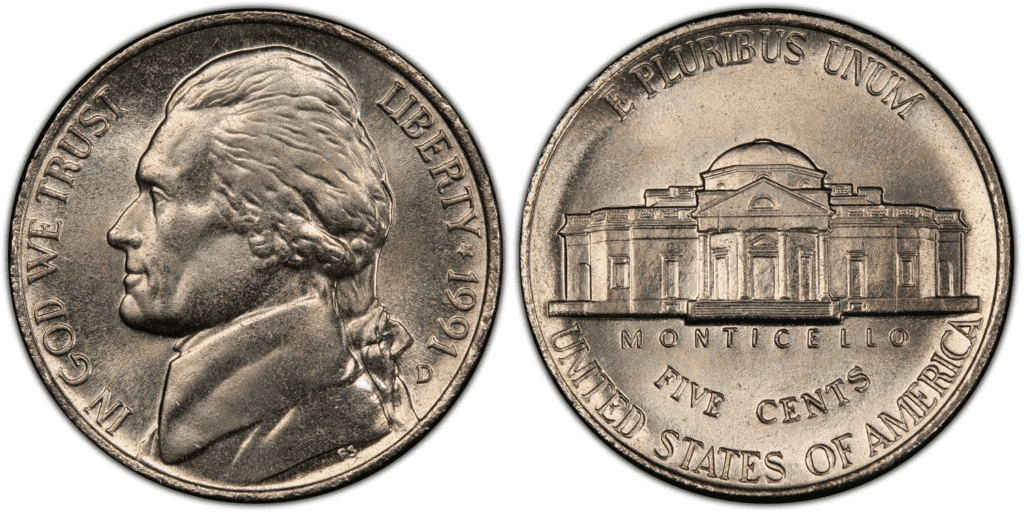
The Denver Mint produced more than 436 million nickels in 1991. While this figure may look big, it is actually smaller compared to 1990’s 663 million plus nickels and 1992’s 450 million plus nickels. Circulated coins may be just between $0.10 and $0.20.
1991 S Jefferson Nickel
Year of minting: 1991
Mint Mark: S
Minted in: San Francisco
Quantity produced: 2,867,787
Face Value: $0.05
Price: $5.14 or more (Mint State)
Mass: 5.00 grams
Edge: Plain
Designer: Felix Schlag
Composition: 75% Copper, 25% Nickel
Diameter: 21.20 millimeters
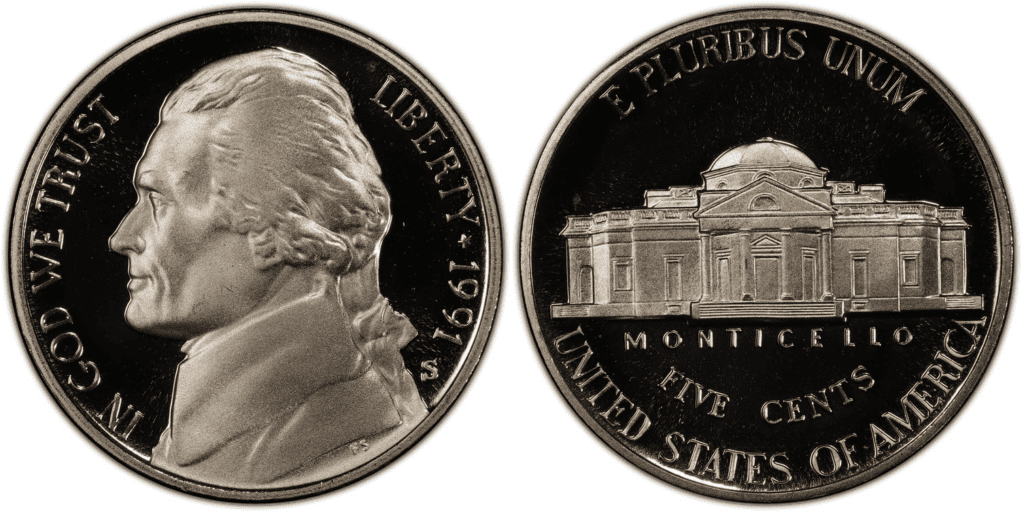
The San Francisco Mint produced more than 2.8 million proof coins. Due to the upgraded minting process, you should find PR69 and PR70 graded 1991 S-proof nickels with relative ease.
As you may already know, proof coins are different from normal coins. For one, proof coins are specifically made for collectors. Aside from that, proof coins are more beautiful and attractive. This made proof coins to be more time-consuming and difficult to produce.
That’s why you will notice that the mintage figure for the 1991 S nickels is significantly lower compared to the mintage figure of other minting centers.
1991 P Jefferson Nickel
Year of minting: 1991
Mint Mark: P
Minted in: Philadelphia
Quantity produced: 614,104,000
Face Value: $0.05
Price: $0.33 to $3.06 (circulated condition)
Mass: 5.00 grams
Edge: Plain
Designer: Felix Schlag
Composition: 75% Copper, 25% Nickel
Diameter: 21.20 millimeters
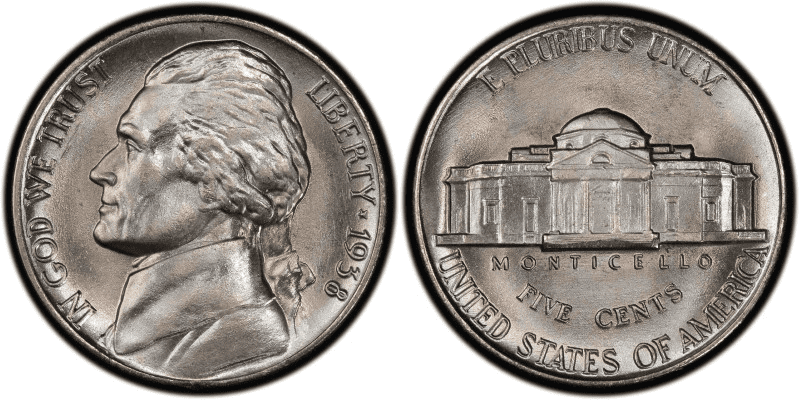
The Philadelphia Mint produced more than 614 million nickels in 1991. This makes the 1991-P nickel the most abundant variety in the 1991 nickel series. You should be able to sell this coin for around $0.33 to $3.06.
List Of 1991 Jefferson Nickel Errors
The US Mint produced more than a billion Jefferson nickels in 1991. With a massive mintage figure like this, it is unavoidable to have error coins.
Here are some examples of the error coins in 1991 Jefferson nickels:
DDR or DDO error
Doubled die reverse (DDR) or doubled die obverse (error) happens when the die struck the planchet twice. As a result, the coin has a doubled appearance on its engraved letters or images.
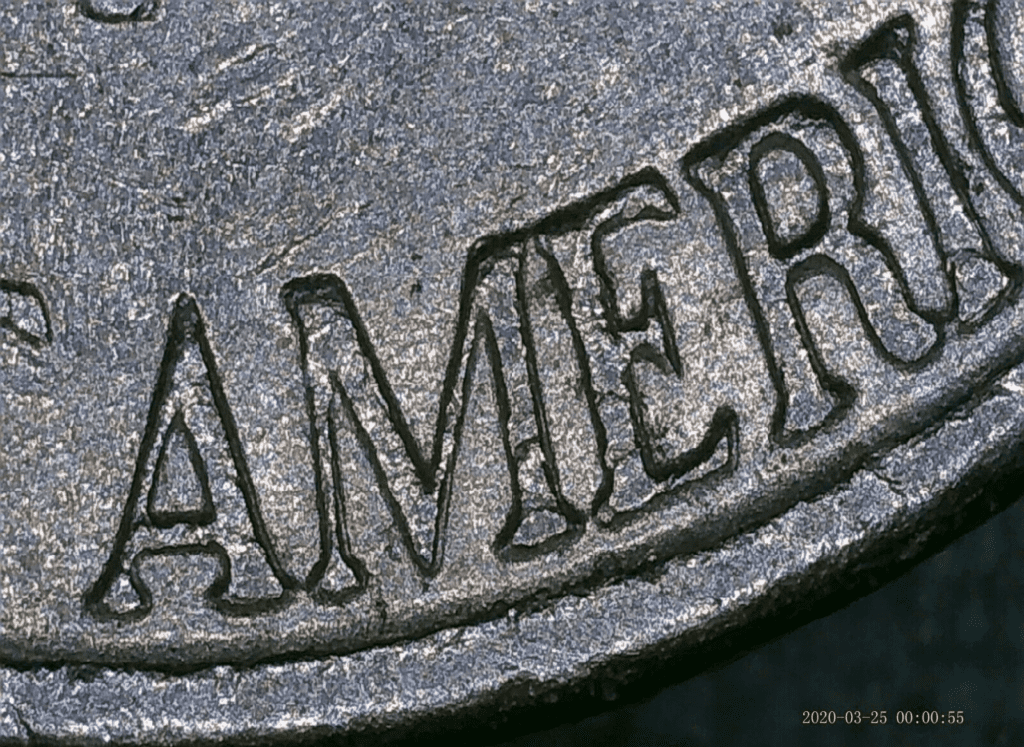
DDR or DDO isn’t always visible to the naked eye. In most cases, the two die strikes hit the same angle, so the doubling isn’t obvious. However, if you find a DDR or DDO error with prominent doubling, then that coin could be worth a lot of money.
Strike-through errors
There are times when a foreign object comes between the die and the blank coin. When the die struck the coin, the die struck through the foreign object, leaving a mark on the coin or preventing the die from fully hitting the coin.
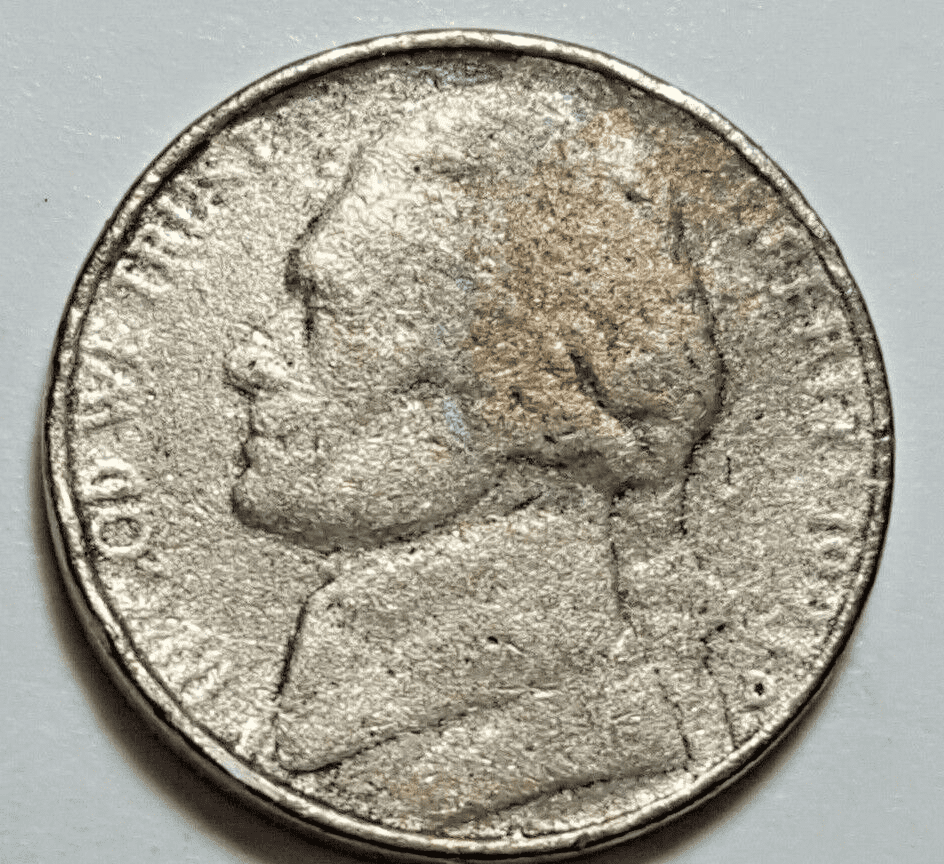
Foreign objects can be metal shavings, staples, cloth, and even grease.
Broad strike
The blank coin is held by a die collar. When this die collar is at the wrong angle or is loose, it can produce a broad strike error.
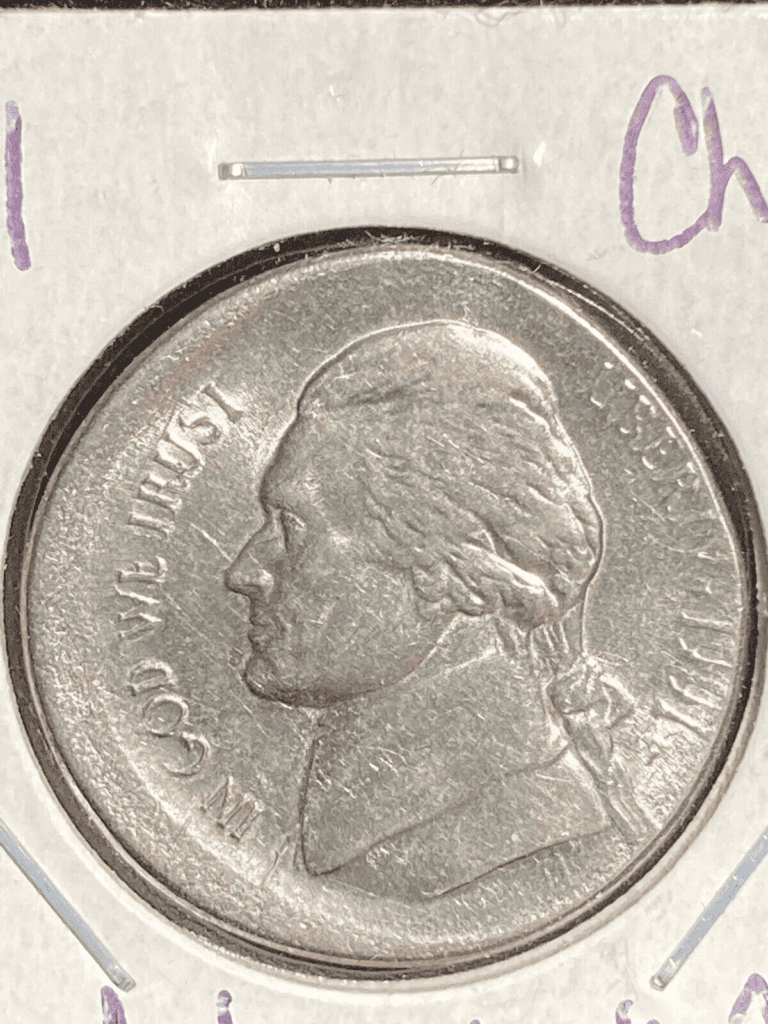
The strike force causes the coin to spread out like a pancake as you can see in the image above.
Off-center strike
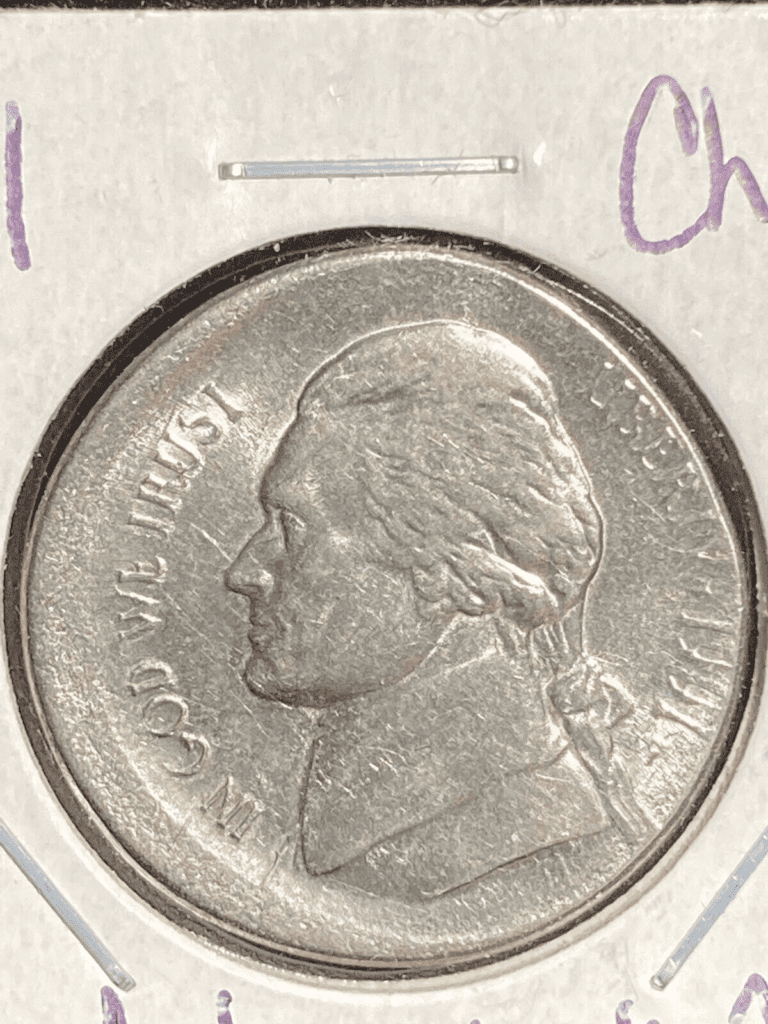
The 1991 nickel off-center strike error coin happens when a coin is struck at a different angle.
The off-center strike error can be very obvious, depending on the degree of the off-centeredness of the strike. In some error coins, you can even see some portion of the blank planchet space.
How Much Is 1991 Jefferson Nickel Worth Today?
The 1991 Jefferson nickel has a face value of 5 cents. It’s not much if you ask most people. Even its melt value, which is $0.0714, isn’t that much.
According to USA Coin Book, a 1991 Jefferson nickel in circulated condition can be about $0.33 while an uncirculated version can fetch up to $3.06. The proof version of the 1991 nickel is more expensive, which is around $5.14.
As this might be the case, there are still 1991 Jefferson nickels that are worth more than their face value and melt value. Here’s a table to show you the auction records based on PCGS’ website:
| Coin | Condition | Grade | Sold date | Sold by | Value |
| 1991 S proof Jefferson Nickel | Superb Gem Uncirculated | MS 67 (Full Step) | June 10, 2022 | eBay | $950 |
| 1991 D Jefferson Nickel | Superb Gem Uncirculated – Full Step | MS 66 | July 26, 2008 | Heritage Auctions | $403 |
| 1991 P Jefferson Nickel | Superb Gem Uncirculated – Full Steps | PR 69 (Deep Cameo) | August 13, 2020 | eBay | $330 |
As you can see, there are still 1991 nickels that are worth a lot of money. Moreover, if you have error coins, they can also be sold more. For example, a 1991 nickel with a DDR error is being sold for $50.
How Does The Grading System Work?
The 1991 nickel coin is graded with the use of the Sheldon Scale. It’s a 70-point grading scale that helps people know the condition and possibly the value of a coin.
Moreover, a 1991 nickel would also be categorized as MS (Mint State) or PR (Proof). Mint State is designated to coins made originally for circulation. PR is given to coins that were struck as proof coins.
The highest grade a 1991 nickel coin could ever get is MS70 or PR70. When you have a coin with this grade, it means that the coin is utterly flawless. You can’t see any scratch or damage on it. Plus, you also get to see how its original luster and color were well preserved.
For 1991 nickels, there’s also a specific grading for it. A nickel coin can be categorized as Full Step or Non-Full Step. If you look at the Monticello mansion on the reverse side of the coin, it has steps leading to it. If the steps are fully visible, showing 5-6 steps, then the coin can be referred to as Full Step.
For the proof coins, there’s also a special designation that includes Proof, Cameo, and Deep Cameo. Cameo refers to the degree of contrast between the engraved materials and the background of the coin. The more pronounced, detailed, and shiny the coin, the more likely it will be called a Deep Cameo.
Professional numismatists joined together in the 1970s and established CoinGrading standards. These numismatists now assign grades at key places on the seventy-point scale, using the most regularly utilized numeric points in conjunction with the original adjective grade. The following are the most common coin grades:
-
-
- (P-1) Poor – Indistinguishable and probably damaged; if used, must have a date and mintmark; otherwise, rather battered.
- (FR-2) Fair – Nearly smooth, but without the damage that a coin graded Poor often possesses. The coin must have enough detail to be identified.
- (G-4) Fair – Inscriptions have merged into the rims in some areas, and important elements have been mostly erased.
- (VG-8) Very Good- A little weathered, but all of the primary design elements are visible, albeit faintly. There is little if any, central detail left.
- (F-12) Good – The item is very worn, yet the wear is even, and the overall design details stand out clearly. Rims are almost completely isolated from the field.
- (VF-20) Very Fine – Moderately weathered, with some finer features still visible. The motto or all letters of LIBERTY are readable. Both sides of the coin have entire rims that are separated from the field.
- (EF-40) Extremely Fine – Gently used; all gadgets are visible, and the most important ones are bold. The finer details are bold and clear, however, light wear may be seen.
- (AU-50) Uncirculated – Slight evidence of wear on the coin’s design’s high points; may have contact marks; eye appeal should be adequate.
- (AU-58) Uncirculated Choice – Slight traces of wear, no severe contact marks, almost full mint shine, and great eye appeal.
- (MS-60) Mint State Basal – Strictly uncirculated; no indication of wear on the coin’s highest points, but an unsightly coin with reduced luster, visible contact marks, hairlines, and other flaws.
- (MS-63) Mint State Acceptable – Uncirculated, but with contact scratches and nicks, little reduced shine, but otherwise appealing appearance. The strike is weak to average.
- (MS-65) Mint State Choice – Uncirculated with great mint shine, very little contact blemishes, and exceptional eye appeal. The strike is unusually severe.
- (MS-68) Mint State Premium Quality – Uncirculated with superb luster, no obvious contact marks to the naked eye, and exceptional eye appeal. The strike is quick and appealing.
- (MS-69) Almost Perfect Mint State – Uncirculated with perfect brilliance, a sharp and appealing strike, and extremely good eye appeal. A near-perfect coin with minor imperfections in the planchet, strike, and contact markings (seen only under 8x magnification).
- (MS-70) Mint State Perfect – Under 8x magnification, there are no tiny imperfections discernible; the strike is crisp, and the coin is perfectly centered on a beautiful planchet. Rarely seen on a coin, this coin is bright and whole, with original luster and exceptional eye appeal.
-
Where To Buy Or Sell 1991 Jefferson Nickel?
You can buy 1991 Jefferson nickels in coin shops, antique stores, and even pawn shops. However, looking for old Jefferson nickels in stores or shops can be difficult since you have to physically travel to these places without any assurance that you’ll find a 1991 Jefferson nickel.
The most common and easiest way to find a 1991 Jefferson nickel today would be on the Internet. All you have to do is use keywords like “buy 1991 Jefferson nickel” or “sell 1991 Jefferson nickel.” A simple Google search should give you hundreds of related search results.
On top of the results would most likely include eBay and Amazon. These online platforms are great places to both buy and sell 1991 Jefferson nickels.
FAQs
How much does a 1991 nickel weigh?
The 1991 nickel has a weight of 5 grams.
Is a nickel from 1991 worth anything?
Yes, a nickel coin can be worth a few hundred dollars if it is in good condition. Rare 1991 nickels, such as those that come with errors, could also be worth more than their face value.
How much is a 1991 D nickel worth?
The 1991 D nickel is worth 5 cents if it is in circulated condition. However, if it is in uncirculated condition or it is officially given a high grade, the coin can be worth $50 or higher. The current auction record for a 1991 D nickel is $403.
